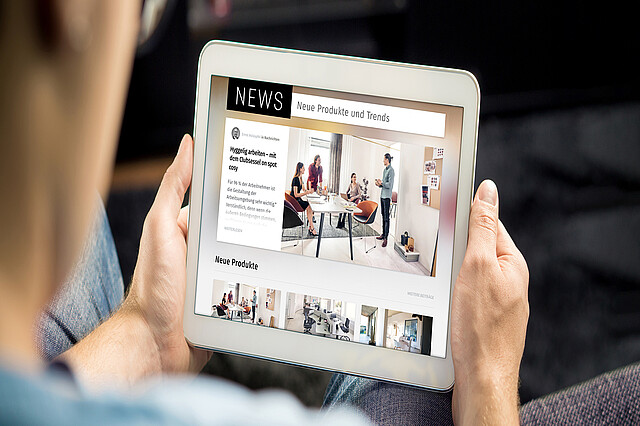What were the particular challenges in redesigning the church? What was the focus of the interior design?
One of the bigger challenges was the heating concept. Here, our landlord and the architects decided on an attached, second floor with heating in order to heat the nave as energy-efficiently as possible. The focus of the furnishings was, on the one hand, on a high-quality and modern interior and, on the other, on a room layout that simultaneously allows concentrated work but also offers many places for communication, meetings and exchange – such as in the meeting cubes and seating groups.

To what extent has the original structure of the church been preserved and which elements from days gone by can still be found in the building today – perhaps in a different function?
The structure of the church has been almost completely preserved. Only the sacred objects such as the main altar and the organ have been removed. Many elements from days gone by are no longer used; only the old cupboards in our meeting room “sacristy” come to mind. And the choir area is still the space where the stage is during events and where the speakers stand.

(Photo: digitalHUB Aachen e.V., Bernadette Trepte)
Is the “church” completely out of the church or are there still connections to the archdiocese, priests and co?
We have a close connection to the diocese of Aachen. The diocese is an active member of our association and is involved in our ethics focus group, for example, which discusses ethical issues in connection with digitalisation and AI.

(Photo: digitalHUB Aachen e.V., Bernadette Trepte)
Not many people would associate a church with a workplace. What do customers particularly appreciate about the coworking church concept?
We often get feedback from our coworkers that the church has a special spirit and helps them to be creative and visionary with the large, open nave, but also the many nooks and crannies and retreats.
There is round-the-clock access to the building and workplaces – are there many early birds and night owls?
There are definitely early birds and night owls. But there are also coworkers who come early and stay late and sometimes even work here at the weekend. Founding a start-up involves many intensive work phases and also the odd night shift, so it was important to us to provide 24/7 access for our start-ups.

(Photo: digitalHUB Aachen e.V., Bernadette Trepte)
Which target group is the offer aimed at and is there a professional group that particularly likes to use the space?
The coworking space is primarily used as a workplace by start-ups. Our medium-sized member companies use coworking now and then as a change from their permanent office or home office, but more often they use our meeting rooms.
In terms of industries, as a digitisation centre and incubator for digital start-ups, we naturally attract many techies, computer scientists and software companies. But since digital transformation affects companies in all sectors, this is also reflected in our member companies. From software and cosmetics companies to medical technology companies, a wide variety of sectors are represented here.
With reference to times past – is there a special spirit of sharing and cooperation at digitalCHURCH?
There is definitely a special, creative spirit and a spirit of sharing here. I have often experienced this myself, but I also hear it back again and again from start-ups and companies. There is a great willingness to help in our community, which became very clear during the pandemic and also during the flood disaster. Within a very short time, members of our association had issued numerous offers of help. The motto which prevails here is: “Give, Give, Ask”.

(Photo: digitalHUB Aachen e.V., Bernadette Trepte)
social media channels:


